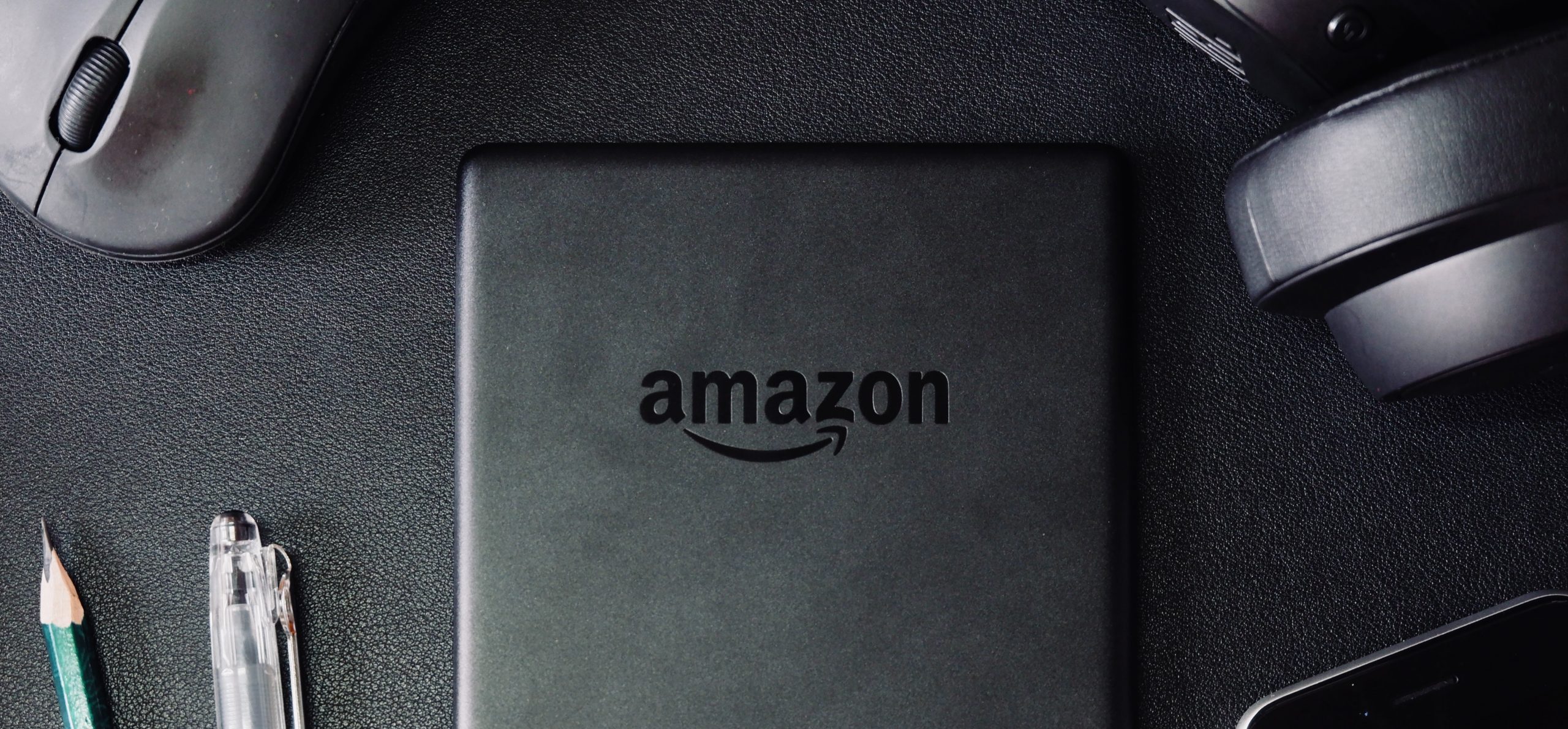Getting products in front of Amazon buyers is as easy as P-P-C… as long as you avoid these common mistakes.
Here you’ll find:
- What Amazon PPC campaigns are and how they work
- Common mistakes Amazon sellers make with their PPC campaigns
- How to start an Amazon PPC campaign (and the benchmarks to aim for)
- Expert tips to improve your Amazon PPC campaigns
Selling on Amazon for the first time can bring about serious opportunities (and customers).
But getting “foot traffic” to your Amazon store can take weeks, or even months, especially if you rely on organic search. No one’s got time for that, especially when you have a product to launch or a sales goal to smash.
So creating product listings, then wishin’ and hopin’ for Amazon shoppers to find ’em just won’t cut it. This is where Amazon pay-per-click (PPC) ads can… well, pay off.
Let’s explore how PPC campaigns can make your Amazon store gain traction and sales.
What is an Amazon PPC campaign?
An Amazon PPC campaign is a method e-commerce sellers and marketers use to buy sponsored product listings on the Amazon marketplace. It helps sellers gain visibility for products shoppers otherwise wouldn’t find because your listing sits on the umpteenth page.
Pay-per-click ads are a quick way to build traffic to your Amazon store. These appear in the search results on Amazon, but you don’t pay a penny until someone clicks on your ad. The fee per click varies, depending on the keyword of the ad and how much competition there is for it.
Where do Amazon ads appear?
Amazon ads appear throughout the Amazon marketplace. The first you’ll see is at the top of your search results. Here’s an example of the sponsored ads for the search term “organic coconut oil”:
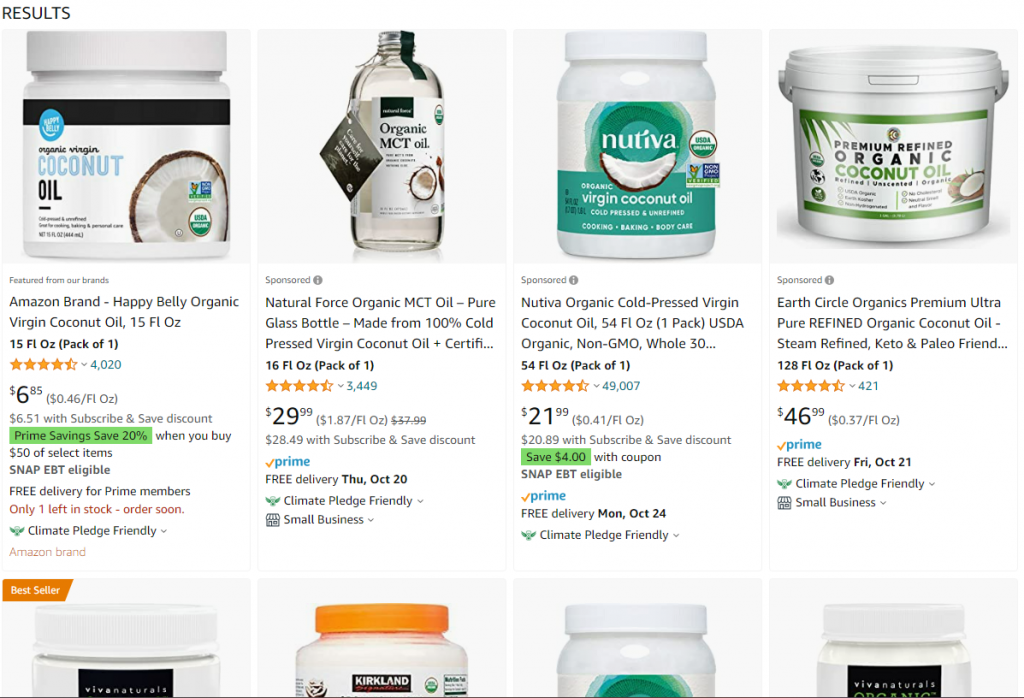
Then when you scroll down, you’ll also find them mixed into the search results:
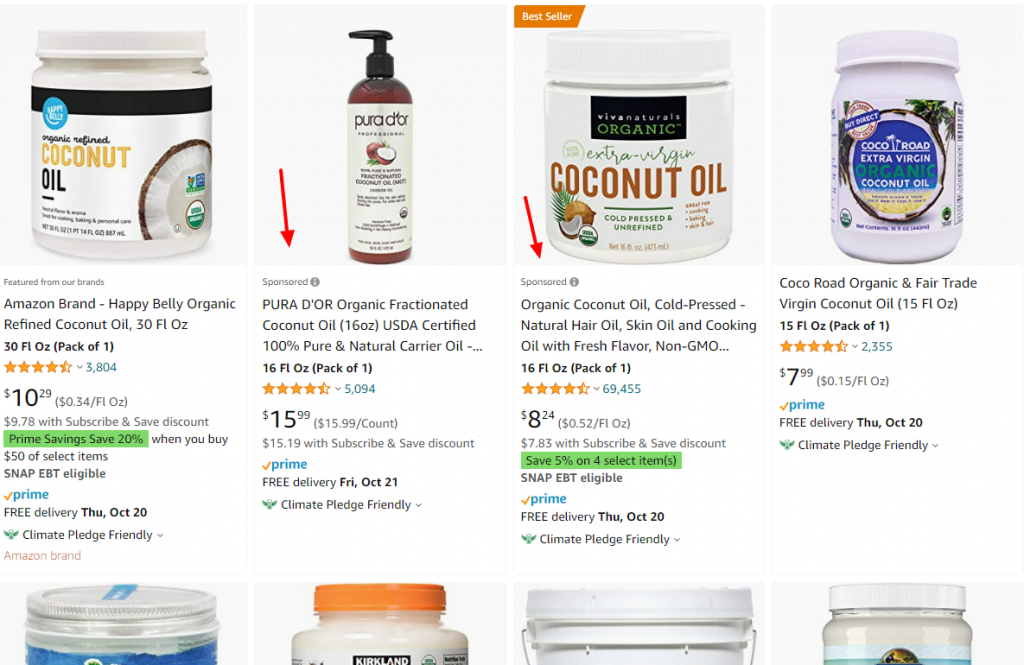
You’ll also find them within product detail pages beneath the product description:

Amazon recently released a new type of sponsored product listing, which appears on the search result page. But it’s exclusive — it’s only available to highly rated products, which means you need to put in work to build positive reviews and ratings.
It looks like this:
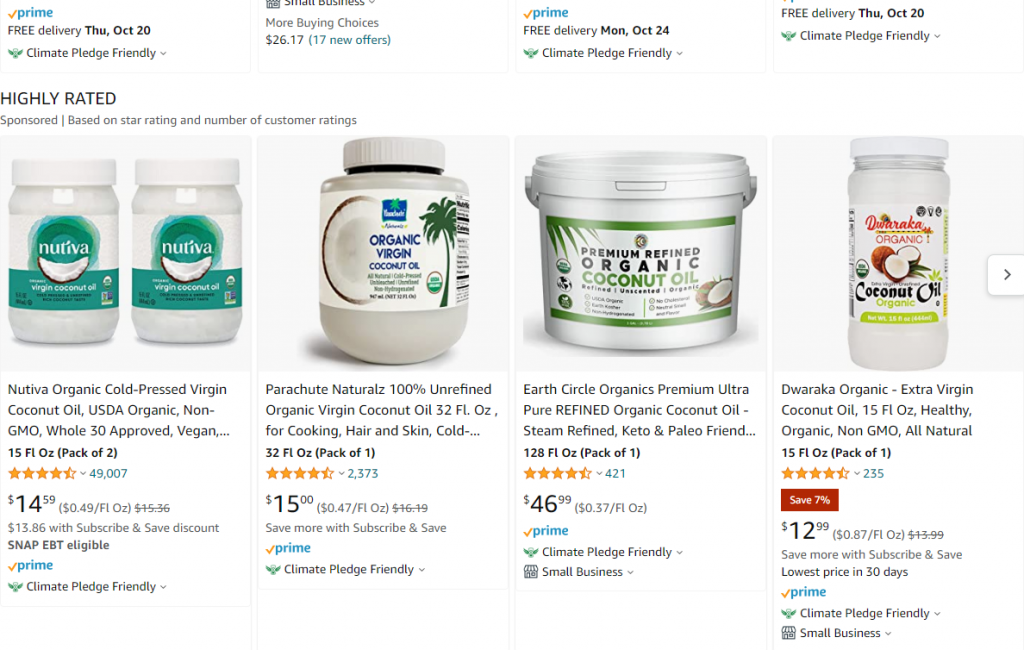
What are the fees for Amazon PPC ads?
PPC ad fees on Amazon vary depending on the keyword you select. The higher the competition (tons of people bidding on it for their ads), the higher you’ll pay.
So the goal is to choose a keyword that’s relevant, low-competition, and receives a lot of customer searches.
When you create your PPC campaign, you’ll see the CPC (cost per click). From there, you can determine how much you want to spend daily, weekly, or monthly. Once your limit is reached, the ads will turn off for the rest of the day, week, or month.
CPC can be as low as $0.02 or as high as $10+. However, the average as of June 2021 is $1.20 per click.
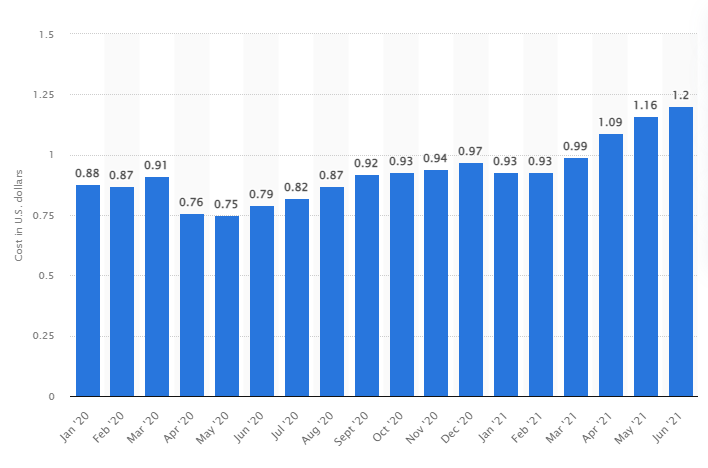
Source: Statista
It’s worth noting that Amazon’s Sponsored Product ads (our favorite) are cheaper than both Facebook and Google Search ads, according to a Benchmarks report by Sellics.

Why are PPC campaigns important for Amazon sellers?
Running pay-per-click ads is a good idea for new Amazon sellers struggling to generate traffic to their listings. In the beginning, it’s harder to gain trust because you have little-to-no reviews or ratings.
Another reason to use PPC campaigns is if you have an established Amazon business that wants to run a sale or increase revenue. Either way, pay-per-click advertisements help get your products in front of potential customers.
Both vendors and sellers can use PPC campaigns to grow their brand visibility and product sales.
Benefits of running PPC campaigns on Amazon
Amazon makes it easy to create and manage PPC campaigns. You decide the:
- Length of the campaign
- Keywords to target (or automate targeting)
- Products to advertise
- Amount you’re willing to spend/bid
So you’re in complete control. Once your campaign launches, you can see an increase in traffic and sales.
Here’s a look at the results Amazon sellers have seen in the past:
- 40% increase in weekly unit orders within the first year of launching a campaign
- 54% increase in weekly glance views within the first year of a campaign launch
- 55x increase in impressions (by adding three or more bullet points to the product page and showing Sponsored Products)
- 93x more units sold by adding A+ content to the detail page, and including Sponsored Products
When is a good time to launch Amazon PPC campaigns?
If you have the budget to pay for advertising, then now is always a good time. This is especially true if you’re looking to get more eyes on new products to increase revenue.
Maybe you’re struggling to grow your Amazon store during the first year. Or maybe you’re established, but competition is growing, and it’s decreasing your revenue. These scenarios make Amazon marketing a solid idea.
Also, the sooner you invest in Amazon PPC advertising, the quicker you get meaningful insights. In your dashboard, you’ll find information about how customers search for your products.
This helps with optimizing PPC ads, as well as product pages, since you know which keywords to add to your title and description. And it’s a great strategy for the holidays since it’s the time for massive sales and competition for the first page.
But it’s not just a seasonal “tactic” — it’s something you want to do year-round because it can boost your organic ranking. With a successful PPC campaign, more people will see and click your listings. And the more they click, the more conversions you get. All of this tells Amazon’s algorithm that your listings are worth a rank boost.
So if you have new products or products with a short history, then launch PPC campaigns to give them a nudge.
How do Amazon PPC ads work?
Amazon paid search uses an algorithm to help shoppers find the products they’re looking for. It works like this:
- A shopper enters a keyword phrase like “king size bed sheets” into Amazon’s search bar
- Amazon’s algorithm analyzes millions of product listings, searching for those using the keyword and related terms in its product title and description
- Search results showcase the most relevant products at the top of the first page
- In the mix of the organic search results are sponsored listings, which appear at the top and bottom of each page, in side banners, and throughout search results
To have your products appear in the sponsored product sections, you must set up a paid advertising campaign, create an ad, and set a budget and time frame.
Since the sponsored ad program is auction-based, keyword bidding is required. But it’s not just the highest bidder that wins ad placement — it’s also the:
- quality of the listing
- user experience
- whether you won the buy box
- your seller ratings
Like Google, Amazon is putting the customer first. As a result, the most relevant ad wins in the end.
Types of Amazon PPC ads
Now, there are several campaign types for Amazon PPC ads. We already covered sponsored product ads, which are used to promote specific products and appear in relevant organic search results. Once clicked, the shoppers land on the product page.
The other two include ad types include:
Sponsored brand ads
Brand ads, also known as headline ads, help build brand awareness and sales by allowing sellers to showcase multiple products in one ad. It contains your brand logo, product images, and custom headline, and takes shoppers to your brand’s store (or group of products the ad promotes).
According to Amazon, sellers can:
- Increase return on ad spend (ROAS) by 5.5% when combining sponsored brand videos, custom ad images, and Store spotlight formats.
- Boost conversion rates by nearly 58% by combining custom images and Amazon Store spotlight ad formats.
- Grow click-through rates (CTR) by more than 108% using brand video ad formats.
These ads appear at the very top (headline) of specific categories.
It looks like this:

Sponsored display ads
Display ads engage shoppers interested in certain categories related to your product, or shoppers that viewed your product without making a purchase. You can also target specific categories or products similar to yours.
Based on Amazon’s data, sellers can use these ads to:
- Increase impressions by 2x and clicks by 1.5x using Amazon’s contextual targeting recommendations
- Drive sales from new-to-brand customers by 82%
- Boost year-over-year (YoY) sales by 15% using a balanced budget for product, brand, and display ads.
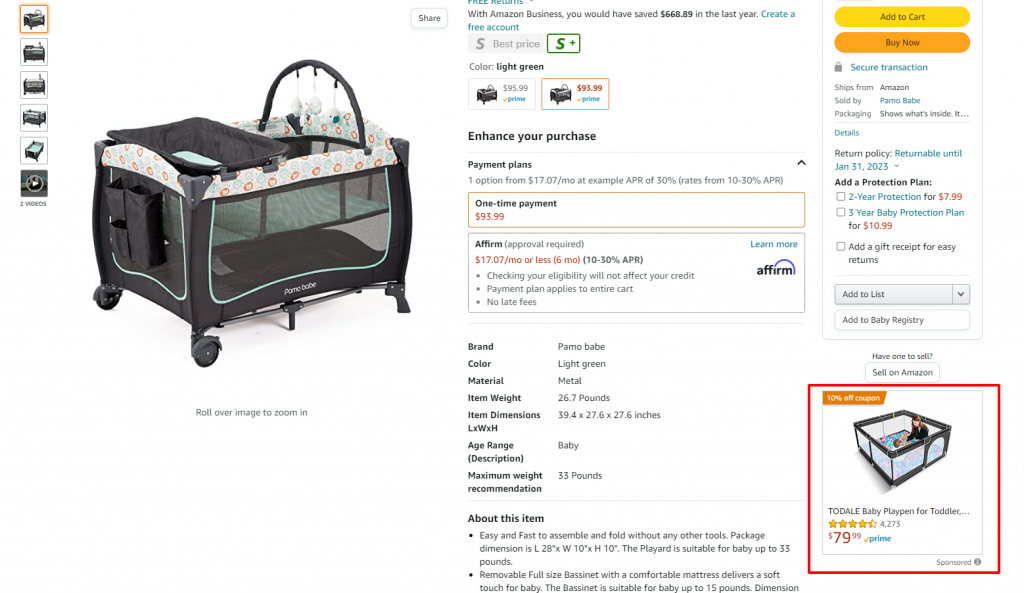
But which type of PPC ads should Amazon sellers use and why? Melissa Torre, Senior Search Engine Marketing Manager at HawkSEM, offers advice to those with registered brands on Amazon:
“Headline image ads, manual sponsored products, and video ads can demonstrate authority, helping you gain the customer’s trust. Some marketers use them only for branded terms, but to have a robust account, landing on the front page by using top-performing product keywords and multiple ad types is extremely effective.”
It makes perfect sense — the more someone sees a product or brand, the more familiar they become, and the higher trust builds.
Torre also states that although Sponsored Product category ads don’t convert well, they’re an excellent higher-funnel branding tactic in a lower-funnel platform like Amazon.
For instance, if you target a paint category for your painter’s tape product, you can drive shoppers to your listing fast (before they even know they’ll need your item). Plus, it builds brand recognition.
Amazon keyword match types
There are three keyword match types available for Amazon PPC campaigns: broad match, phrase match, and exact match.
Here’s a simple breakdown of each:
- Broad match allows advertisers to target any combination of words for a keyword. For example, your “paint roller” ads will appear for both “paint rollers” and “rollers for painting.” Or it can replace terms like “paint” with “pigment” and “roller” with “brush.” Broad matches are generally best suited for low-competition keywords with little search volume.
- Phrase match allows advertisers to target keywords that appear in any order and with various synonyms, prefixes, and suffixes. For example, your “girl dresses” ads can appear for both “summer girl dresses” and “girl dresses for weddings.”
- Exact match requires that all words be exactly matched with your targeted keyword.
You have two options for selecting keywords for your campaigns: manual targeting or automatic targeting.
With the manual option, you’re selecting the keywords to bid on for your ads. Automatic campaigns use Amazon’s algorithm to select keywords relevant to your product listing.
It gathers data over time, such as shopper clicks and purchases, to determine the best keywords to boost conversions.
How to jumpstart your Amazon PPC campaign
It’s time to build your first campaign on Amazon. Where do you begin? Here’s how to get started:
- Select product(s) from your store to advertise
- Conduct keyword research to determine high-search, low-competition phrases to add to your campaign and ad (or opt for the automatic targeting option)
- Optimize your product ads using the keywords selected by adding the terms to your title, description, and features
- Add images of your products (make sure they’re high-quality)
- Include benefits of your product, not just the features, to garner more clicks
- Build your campaign by going to “Advertising” tab in your Seller Central account, then selecting “Create campaign”
- Select between Amazon Sponsored Products, Display, or Brands campaign and walk through the setup (e.g., create campaign name, start/end date, and daily budget)
- Decide whether you want to use manual or automatic targeting
- If you choose manual, then upload your keywords (can add up to 1,000, but aim for a few dozen)
Benchmarks for PPC campaigns on Amazon
What makes an Amazon PPC campaign a success? It depends on the results. One way to find out is to compare your campaign to the outcomes of others.
One metric to review is the advertising cost of sale (ACOS), which is the percentage of revenue generated by a campaign that’s spent on advertising. Calculating this determines the profitability of your ads.
To calculate, use this formula:
ACOS = total ad spend / total ad revenue x 100
For example, if your PPC ad campaign generates $500 in sales and costs you $50, then it’ll look like this:
$50 / $500 x 100 = 10% ACOS
This means you spend 10% of your sales on advertising, which is helpful for calculating your budget when increasing or decreasing your ad expense.
The goal is to keep your ACOS low. Based on analytics software company Sellic’s 2022 benchmark report, the average ACOS for Sponsored Product ads is more than 33% as of 2021.
Then when you look at conversion rates (# of orders / # of clicks), the average in 2021 rose to 8.4%.
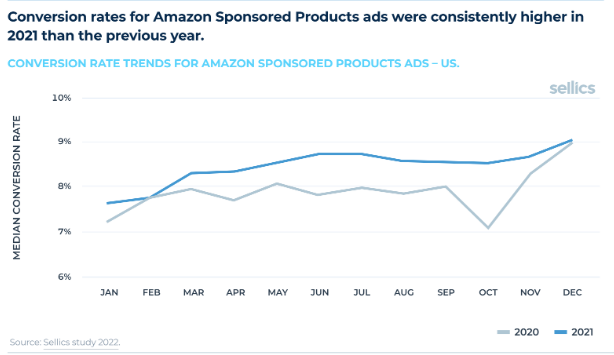
Source: Sellics
Pro tip: To ensure you’re on the right track, keep your ACOS below 33% and conversion rates at 8% or higher.
Avoid these mistakes when running your Amazon ad campaign
Amazon Advertising is a useful tool to take e-commerce sales to the next level. But only if you know how to use it. Let’s start with common mistakes you should avoid.
Data dumping
Keyword research can make or break your Amazon campaigns. But pinpointing the best keywords to include in each ad group isn’t always simple. So some will build a long list — sometimes with hundreds of keywords — for a single ad group.
The problem:
“This keeps us from finding what works and what doesn’t,” says Torre. “Splitting ad groups by 20 or fewer keywords is ideal.” Fine-tune your keyword list now and save yourself from going through mounds of data with a fine-tooth comb later.
Running ads on branded terms only
It’s tempting to target branded keywords because it has little to no competition. But if this is your one and only Amazon PPC strategy, then this won’t cut it.
“Brands will always dominate — and Amazon will always prioritize — branded search terms because it delivers easy results,” Torre explains. Unfortunately, it will also falsely inflate the ROAS/ACOS and make the agency or campaign manager look great but won’t add much to the bottom line,.”
So make sure you’re running campaigns for non-branded keywords to balance your campaign results and boost your revenue potential.
Relying on automated campaigns (when your listings are poorly optimized)
Optimizing your sponsored product listings takes time and effort to get results. But as a seller, time isn’t always on your side. So you figure automating keyword targeting will save the day.
And sure, it may help optimize your ads for better results. However, you don’t want to rely on bots to run your campaigns full-time (or at all) if the listing is poorly optimized. If your listing only has a few strong keywords, then the auto campaign will struggle to find new customer search terms to target.
Tips for running successful Amazon PPC campaigns
Now, let’s get into what you should do with your Amazon PPC campaigns. Here are tips shared by our search engine marketing manager.
Set up automated campaigns
At the start of your ad campaign and want to experiment with automation?
“As long as your listings are optimized, allowing the Amazon algorithm to search for keywords that convert while you’re testing manual campaigns helps your overall strategy,” says Torre.
It’s also a good idea to use broad match campaigns with low CPCs to accomplish similar results. Both consider your listing’s headlines, bullet points, and backend keywords when finding searches for ad placement.
“Once you find consistent results, add those search terms to your manual campaigns for more control, then remove them from the auto campaigns,” she adds.
…But make sure to start with manual campaigns
Automatic targeting campaigns are helpful, but don’t become entirely reliant on them (especially at the start of your campaign).
“I always start with manual targeting, starting small and adjusting weekly to ensure I’ve gathered enough data to make an adjustment decision,” says Torre. “Then for prospecting campaigns, I bid up ‘Top of Page’ significantly to capture interest.”
Why does this work? Because most shoppers never make it halfway down the page, let alone the second page. It has a lot to do with decision overload — shoppers want to find what they need fast and can’t do that when they have too many choices.
“I like only appearing at the top page with some of my listings,” she adds. “So I may bid a $0.25 keyword level bid, then raise Top of Page bidding 500% for a total bid of $1.25 — but only for Top of Page.”
Don’t optimize listings too soon
Yes, it’s important to optimize your Amazon ads. But not before you do anything else with your campaign.
“This tends to be overlooked as people start up a PPC campaign. They expect to dominate the first page and boost their listing to the top of the page organically,” says Torre.
Truth is, Amazon’s algorithm looks at multiple factors when deciding where your listing quality score, such as your:
- CTR
- Conversion rate
- User experience
If your listing is missing images, information, or relevant keywords, then shoppers will likely go on to another listing. So why would Amazon take chances with placing a product listing that won’t get clicks?
“No amount of PPC spend can help a listing that isn’t optimized. It can even hurt a seller’s chances of ever taking the first page organically,” says Torre.
This is why we spend a lot of time optimizing our clients’ listings. For example, we had a client selling auto parts. Normally, we’d run terms for those parts using product-specific keywords like materials, features, and make/model of the vehicle.
However, we tested a few short two-word broad match Sponsored Product campaigns using make and product type, like “F-150 shocks.” And guess what happened — we killed it (in a good way).
But we still had to be cautious of irrelevant terms. Thankfully, the algorithm did an excellent job of optimizing the listings using strong terms (similar to an auto campaign). So the results were outstanding.
Use data to guide keyword research
If you run PPC ads on other platforms (e.g., Google, Bing, Facebook), use this data to identify search trends and find keywords to use in Amazon listings.
Another option is to use tools like ConversionIQ, HawSEM’s proprietary software, to find low-competition keywords faster. And identify your top customers (and their keywords) to create highly-targeted ad campaigns that maximize clicks and conversions.
Setting up auto campaigns can also aid in finding keyword ideas for your ads.
When looking through your Search Ads data, ignore intent terms like “near me” or “buy.” These terms are relatively useless on Amazon, since it’s assumed shoppers are there to find and purchase products.
“Instead, describe your products using colors, sizes, types, user terms, and strongly searched features (e.g., adjustable) to get clicks from shoppers who are ready to buy now,” adds Torre.
Build product pages with user experience in mind
Your ads are only the first touch point with a customer. The next step is the landing page (aka your product description page). So making your product pages attractive and helpful is critical.
It’s what makes the user experience great and potentially converts clickers into buyers. Plus, the longer someone stays on your listing shows Amazon’s algorithm your listing is worth ranking in search results.
If you have a registered brand on Amazon, consider using their templates to set up your product page. Make sure to add:
- High-quality product images
- Product and seller information
- Social proof (in the form of ratings and reviews)
If you have multiple options for an item, create a Variations Listing to showcase other options. This reduces the need to visit multiple listings (improving the customer experience). And increases the odds of customers adding several items to their cart (increasing your revenue).
The takeaway
Growing an e-commerce store on Amazon can be successful, but only when your marketing strategy is on point. By using pay-per-click ads, you can increase your visibility, traffic, and sales faster. However, if you make common mistakes or avoid employing strategies that work, the results will be lackluster.
So use this guide to inform your future Amazon PPC campaigns. If you continue to struggle or lack time to improve your PPC efforts, then consider enlisting the help of an Amazon PPC agency.
Otherwise, it’s time to put your products in front of prospective buyers with the help of PPC. Let’s get it.
